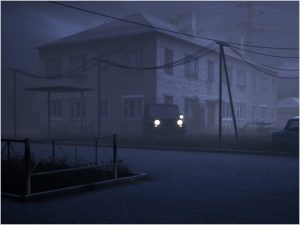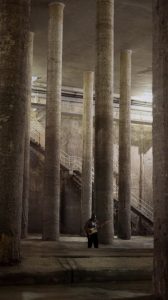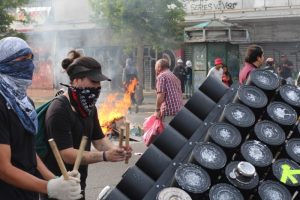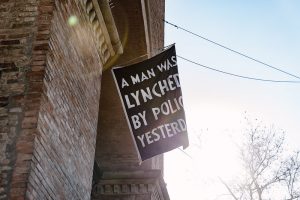 Donning headphones, city dwellers and commuters have been re-shaping the urban soundscape ever since the arrival of the Walkman. A few years ago, Mark Shepard suggested to go beyond this egocasting attitude and share those sounds with the people who might pass by the same spaces. His project is called Tactical Sound Garden and has been presented at festivals and events all over the world, from Sonar in Barcelona to ISEA 2006 in San Jose, from Futuresonic in Manchester to Conflux in New York.
Donning headphones, city dwellers and commuters have been re-shaping the urban soundscape ever since the arrival of the Walkman. A few years ago, Mark Shepard suggested to go beyond this egocasting attitude and share those sounds with the people who might pass by the same spaces. His project is called Tactical Sound Garden and has been presented at festivals and events all over the world, from Sonar in Barcelona to ISEA 2006 in San Jose, from Futuresonic in Manchester to Conflux in New York.
However, the TSG represents only a small part of Shepard‘s activities. His cross-disciplinary practice draws on architecture, film, and new media in addressing new social spaces and signifying structures of emergent network cultures. His research focuses on the impact of mobile and pervasive technologies on architecture and urbanism. He is currently Assistant Professor of Architecture and Media Study at the University at Buffalo, State University of New York, where he is a co-director of the Center for Virtual Architecture.
Your bio say that you’re “an artist and architect whose cross-disciplinary practice draws on architecture, film, and new media in addressing new social spaces and signifying structures of contemporary network cultures.” Do you regard architecture, film and new media as three different fields or does your work encompass them as one?
My work moves between these different fields. I come from a background in architecture, which I’ve studied and practiced (intermittently) over the past two decades. After becoming fed-up with the state of the architectural “profession” in the early 90s, I returned to graduate school and began to work with film as both a medium and a conceptual model to address aspects of spatial experience that elude conventions of architectural representation.
What began as a naive interest in working with time and duration as “material” (qualities of sound, light, movement) led to broader questions concerning how perception is conditioned through the technological apparatus. I was interested in conditions of vacancy as a limit condition within urban environments, and the challenges involved with modeling the forces producing this condition. The work explored the limits of empirical representations, and the political ramifications of the fact that what architects and urban designers perceive and value about a specific site was to a certain extent limited by their ability to represent it. Between Now and There and unfoproject are two examples. Moving between film and architecture (and by extension, cinema and urbanism) provided a means to analyze and critique the techniques by which the built environment is projected and shaped, and in turn, shapes those who inhabit it.
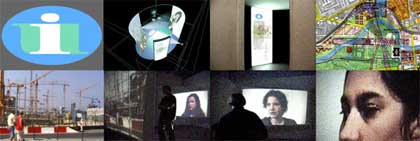 unfoproject
unfoproject
At about the same time, I began to work with new media, mostly as a means to explore non-linear temporal structures and interactivity. A little later, I founded a new media design studio called dotsperinch, together with Carlos Tejada. What started out as as a means to support independent art projects (by freelancing for other artists and designers) grew into a collaborative network of artists, architects, programmers and technologists developing new media environments for primarily non-profit organizations in the arts, design and education communities in New York. Much of the early work with dotsperinch involved designing and programming online digital archives and interactive exhibits for museums. Projects such as 360degrees.org, SonicMemorial.org and CrossingTheBLVD.org provided a pretext to investigate both conceptual design directions and fairly pragmatic development issues involved with creating digital archives and open content systems. Later work, such as Mitosis: Formation of Daughter Cells, an installation by A.M. Hoch at the Beall Center for Art and Technology, explored notions of a “habitable cinema” and involved the integration of sound, the moving image and a mobile observer with things like proximity sensors, mechanical actuators, and embedded microcontrollers.
My current work is more preoccupied with understanding computing as an environment than seeing it as a tool or a set of techniques. When computational intelligence becomes embedded in (or distributed throughout) the built environment, the basis of architecture and urbanism is radically altered. Nowhere is this more evident than in the major cities today. Looking at the impact of mobile and pervasive computing on architecture and urbanism involves rethinking received categories of public/private, individual/mass, interior/exterior, attention/distraction, virtual/actual. I find I’m constantly having to move between different fields to get at the key issues at stake.
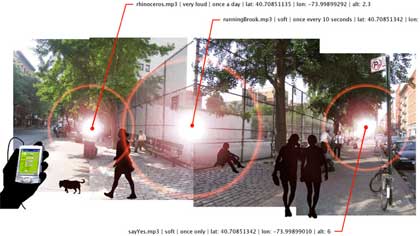 You’ve been working on the Tactical Sound Garden for a few years. How did the project start and evolve?
You’ve been working on the Tactical Sound Garden for a few years. How did the project start and evolve?
The Tactical Sound Garden [TSG] Toolkit began in 2004 as a conceptual mashup of sorts. The idea of participatory sonic environments was something dotsperinch touched on with Sonicmemorial.org, which launched in 2002. Following that we were working with location-aware technologies on projects such as The Rosemary Initiative, which explored the affects of contemporary location tracking technologies on social interaction. In the spring of 2004, I had just finished a proposal with Fiona Murphy for the Maya Lin Plaza at the University of California at Irvine. Maya Lin’s plan for the plaza involved elaborate landscaping combined with various sculptural elements, lighting treatments, and public benches that had audio speakers embedded within them, for example. We were invited to propose a set of scenarios that would augment her plan with a layer of embedded technologies. The idea of “planting sounds” came directly from this proposal.
Early on, I got in touch with Marc Tuters who was working on a project called “Where-Fi” that used 802.11 (WiFi) wireless access points to calculate the location of a mobile device in physical space. Marc pointed me to Placelab, an open source API developed by Intel Research in Seattle that aspired to much of Where-Fi’s design goals (and had a funded development team!). From there, the technology development involved hacking together an application that fed the positioning information from Placelab to a 3D audio engine in order to output a realtime audio mix based on the geographic location of the participant in physical space.
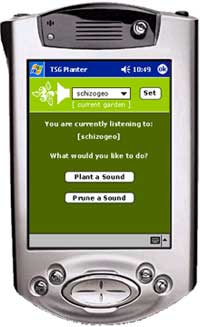 The current interaction model evolved through low-tech studies using handheld transistor radios with small logbooks attached. From these early studies we were able to get a rough idea of how people were inclined (or not) to interact through placing sounds in a “public” space, and some of the parameters that influenced that interaction. While the project draws on the metaphor of actual urban community gardens, virtual sound gardens don’t need to be constrained by the same parameters. For example, physical community gardens are often structured around the idea of the “plot”, where urban public space is spatially partitioned for private cultivation by designated members of a specific community. Given the immateriality of the TSG, and its open participation model, spatial partitioning is one of many possible parameters by which a TSG may be structured. These parameters are being explored through the creation of a series of sound gardens in collaboration with local communities. The idea is to work with communities defined by the shared use of a specific public location – an airport, a park, a street, a plaza – rather than one defined primarily by common property, place of residence, shared interests or beliefs. In this sense, the project seeks to build a sense of community that cuts across demographic divisions, one rooted in the diversity found in the everyday life of urban public space.
The current interaction model evolved through low-tech studies using handheld transistor radios with small logbooks attached. From these early studies we were able to get a rough idea of how people were inclined (or not) to interact through placing sounds in a “public” space, and some of the parameters that influenced that interaction. While the project draws on the metaphor of actual urban community gardens, virtual sound gardens don’t need to be constrained by the same parameters. For example, physical community gardens are often structured around the idea of the “plot”, where urban public space is spatially partitioned for private cultivation by designated members of a specific community. Given the immateriality of the TSG, and its open participation model, spatial partitioning is one of many possible parameters by which a TSG may be structured. These parameters are being explored through the creation of a series of sound gardens in collaboration with local communities. The idea is to work with communities defined by the shared use of a specific public location – an airport, a park, a street, a plaza – rather than one defined primarily by common property, place of residence, shared interests or beliefs. In this sense, the project seeks to build a sense of community that cuts across demographic divisions, one rooted in the diversity found in the everyday life of urban public space.
Tactical Sound Garden requires users to show some respect for other people’s planted sounds. How do you deal with the networks’ vulnerability? How do people usually behave? Do they modify the sounds planted by others? Are there some turf wars? Or are they more ready to collaborate?
This really depends on the community of people involved and the time-scale of their interactions. Interactions within a TSG are best measured in weeks or months (years?), not minutes or hours. For example, when we exhibited the project as part of the ISEA 2006 | ZeroOne San Jose Symposium and Festival, we found the format of the week-long exhibition problematic in that it forced a “demo” mentality on the people who chose to participate. Most people were more inclined to sample the project to see how it works, rather than pursue sustained interactions through it. In this case, people were generally less invested in the sounds they planted, and not that concerned with how others were pruning them. As more Sound Gardens evolve over extended periods of time, we’ll be in a better position to report on how people actually interact within them. They’re still a bit thorny, to be sure!
Are urbanists giving enough attention to the aural layer of the city landscape? If yes, could you give some example? If no, do you think it might change in the future and how?
Sound in modern cities is notoriously difficult to control. Normally, urban planners are concerned with how loud and disruptive cities are, and try to control their sound through codes and legislation. Car horns, police sirens, car alarms left blaring by negligent owners, super-sized car stereo subwoofers, construction workers repairing a water main wielding jackhammers at dawn, or elderly neighbors who are hard of hearing and listen to the television at high volume – each in some way has been regulated by a code or environmental impact study (or occasionally by local intervention of other neighbors…!). So think its less a question of if urbanists are giving enough attention to the aural layer of the city, more one of how they think about sound in cities in the first place.
Mobile audio devices like the iPod have offered the average city dweller alternate modes by which the aural landscape of the city can be augmented and manipulated. The popularity of the iPod points toward a desire to personalize the experience of the contemporary city with one’s own private soundtrack. On the bus, in the park at lunch, while shopping in the deli – the city becomes a film for which you compose the soundtrack. These devices also provide varying degrees of privacy, affording the listener certain exceptions to conventions for social interaction within the public domain. As Michael Bull notes in his book on the subject, donning a pair of earbuds grants a certain amount of social license, enabling one to move through the city without necessarily getting too involved, and absolving one from some responsibility to respond to what’s happening around them. Some people use earbuds to deflect unwanted attention, finding it easier to avoid responding because they look already occupied. Others remove earbuds when talking to someone to signal they want to engage. In effect, the iPod is a tool for organizing space, time and the boundaries around the body in public space.
So today, I think it is more in the hands of the individual to shape her aural experience of the contemporary city than those of the professional urbanists. Without doubt, this contributes to a long-standing retreat or withdrawal of people in cities from urban public space and forms of social interaction found there. And this is the dilemma. One way urbanists might become more involved is to focus on developing new technologies and infrastructures that reconnect people in ways that strike a balance between providing privacy and facilitating openness throughout the social space (which is not always “public” space) of everyday life.
You were one of the organisers of Architecture and Situated Technologies, a “symposium bringing together researchers and practitioners from art, architecture, technology and sociology to explore the emerging role of “situated” technologies in the design and inhabitation of the contemporary metapolis.”One of the issues that the event was addressing was “How do the social uses of these technologies, including (non-) affective giving, destabilize rationalized “use-case scenarios” designed around the generic consumer?” Did the event make the question any clearer? Can you give us an idea of the participants’ view on this?
 I organized the Architecture and Situated Technologies symposium together with Omar Khan and Trebor Scholz. The symposium was a co-production of the Center for Virtual Architecture, The Institute for Distributed Creativity, and the Architectural League of New York, part of the League’s celebration of the 125th anniversary of its founding.
I organized the Architecture and Situated Technologies symposium together with Omar Khan and Trebor Scholz. The symposium was a co-production of the Center for Virtual Architecture, The Institute for Distributed Creativity, and the Architectural League of New York, part of the League’s celebration of the 125th anniversary of its founding.
We were interested in identifying new research vectors, sites of practice and working methods for the confluence of architecture and situated technologies. How might we begin to think about these in a post-disciplinary context, with people coming from related yet different fields? If the point of ubiquitous computing was to make the computer recede to the background, to become invisible, in order to focus attention on the social space of everyday life and the encounters that transpire there, then what kinds of techno-social assemblages are possible or even inevitable? Where will we find them? How will we access them? Who will design them, and based on which criteria?
We began with two usages of “situated” to work with:
1. Situated: located: situated in a particular spot or position; “valuable centrally located urban land”; “strategically placed artillery”; “a house set on a hilltop”; “nicely situated on a quiet riverbank”
2. Situated Action: every course of action is highly dependent upon its material and social circumstances focusing on moment-by-moment interactions between actors, and between actors and the environments of their action.
The first clearly relates to architecture in that architectural design often begins with the site (a specific place or location) as a primary force shaping the act of building. The second stems from a critique by sociologist Lucy Suchman of assumptions about purposeful “human” activity common to artificial intelligence research in the ’80s, which tended to think of this activity as a something that proceeded by an a-priori plan that was perfunctorily executed. Both invoke context (a site, an action, other people) as determining factor in trying to understand the object or event in question.
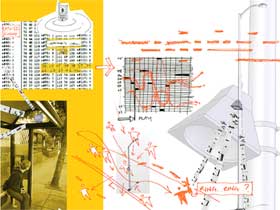 The question of how everyday social uses of different mobile, embedded and pervasive technologies destabilize rationalized use-case scenarios designed around the generic consumer was addressed by a number of the participants. Eric Paulos, director of the Urban Atmospheres group at Intel Research, presented Objects of Wonderment (video): a DIY technology platform for mobile phones that enables users to create their own applications around scenarios specific to their wants/needs/desires given a particular situation.
The question of how everyday social uses of different mobile, embedded and pervasive technologies destabilize rationalized use-case scenarios designed around the generic consumer was addressed by a number of the participants. Eric Paulos, director of the Urban Atmospheres group at Intel Research, presented Objects of Wonderment (video): a DIY technology platform for mobile phones that enables users to create their own applications around scenarios specific to their wants/needs/desires given a particular situation.
Usman Haque‘s talk “Technology and users in public space: what’s wrong with this picture?” argued that the very language often used in talking about the problem of designing techno-social assemblages is itself problematic. He presented a series of projects that recast the user as participant, technology as instrument, and public space as the commons, and opened up a larger discussion about the need for a better vocabulary. We’re currently in the process of placing podcasts of the presentations online. We’re still waiting on a few, but if you view what’s there I think you’ll get an idea of the range of perspectives that were brought to bear on this and other questions.
A&ST also invited artists to give their point of view on the various aspects of situated technologies. How important is the artist’s contribution to technological issues in general? What can their work and views bring to ongoing discussions? Is their voice really heard and listened to outside of the art world?
I think the role of artists in technology development is essential.
They address questions concerning technology that often aren’t asked within conventional corporate research labs, and they do so in ways not obvious (or at least apparent) to computer scientists and engineers. This is by no means new. Artists have been contributing to the development of technology for decades, and places like Xerox PARC and Paul Allen’s Interval Research Lab are just two examples of big players in the tech industry looking to artists to help them think in more inventive and/or relevant ways about future technologies.
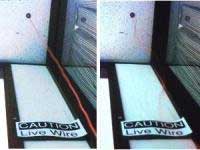 Whether their voice is really heard is another matter. Natalie Jeremijenko–whose project Live Wire (aka the Dangling String) was developed while she was a researcher at Xerox PARC and was cited by Mark Weiser and John Seeley Brown in their 1995 essay Designing Calm Technology –remarked during one of the panel discussions that the lab director succeeding Weisser considered the project “an embarrassment” and had it removed from the lab. In her presentation she argued that while artists are adept at developing scenarios for computing that couple physical and social situations, without some form of quantitative measure to evaluate the performance of the scenario, it is unlikely to have influence beyond the art + technology world: ie: the computer scientists, venture capitalists and other business interests that drive technology development.
Whether their voice is really heard is another matter. Natalie Jeremijenko–whose project Live Wire (aka the Dangling String) was developed while she was a researcher at Xerox PARC and was cited by Mark Weiser and John Seeley Brown in their 1995 essay Designing Calm Technology –remarked during one of the panel discussions that the lab director succeeding Weisser considered the project “an embarrassment” and had it removed from the lab. In her presentation she argued that while artists are adept at developing scenarios for computing that couple physical and social situations, without some form of quantitative measure to evaluate the performance of the scenario, it is unlikely to have influence beyond the art + technology world: ie: the computer scientists, venture capitalists and other business interests that drive technology development.
One of your projects Industrian Pilz is quite intriging. It examines industrialization in East Germany through the lens of mycology – the botanical study of fungi. Can you gives us more details about that project? How do you get the idea?
Industrian Pilz began in 1998 with an invitation to propose an installation for Areale99 – an electronic arts festival set within a robotic manufacturing industrial zone located outside Berlin, Germany in a former East German agricultural region. The project has two components. The “pilzcontainer” installation was conceived as a form of Verpflanzen (grafting), investigating the re-circuiting of industrial production and distribution networks via a site-specific, computer-driven installation that reacted in real-time to the flow of traffic on a nearby autobahn. The “pilzfilm“, a digital video-film exploring the flotsam and jetsam drifting in the wake of West Germany’s absorption of a decaying East German state, documents the context of the industrial zone through a schizoid narrative splicing original investigative footage shot on location with archival film clips, scenes of cultural globalization from popular media, and samplings from the music and musings of pioneering myco-aesthete, John Cage. It premiered at the Viper International Film and Video Festival, Basel, Switzerland in November 2003 and was later screened at Anthology Film Archives in New York.
The initial idea came while I was making site visits to the industrial zone in the fall of 98. I was staying in the next town over and rode by bike through the woods to the industrial zone each day. As I passed through the woods, I kept seeing people moving about seemingly aimlessly, heads bent down, scanning the forest floor. It wasn’t until after a fews days of this that I realized they were foraging for mushrooms. So I thought I’d try it myself. The interesting thing about hunting for mushrooms is that you have to develop a keen eye to locate places in the forest conducive to fungal growth. The average mycophyte also relies on visual cues to determine which mushrooms are safe to eat, and which ones are poisonous. They can be a tasty and nourishing food source, but they can also make you very ill if you are not careful. Mushrooms have no use for the sun. They feed of the dead and decaying matter in the woods. And of course there is a rich mythology surrounding them – toadstools and fairy rings and so forth.

Screenshots from Pilzfilm
I found this an intriguing metaphor for describing the conversion of the former east’s agricultural sector into islands of robotic manufacturing zones feeding the (then) current (re)construction boom in Berlin. In this context, mycology became a device to torque a by now overly familiar opposition between a benign and creative nature and a ruthless culture. As capitalism’s claims to absolute naturalness gain rhetorical momentum, the mycological lens allows models of ‘the natural’ both as the agentless conversion of decaying matter and as a parasitic, potentially toxic, and deeply site specific process – one whose odd position in the economy of matter does not allow easy romantic identifications. Better watch what you eat.
What are you currently working on?
After a number of great discussions this fall in Helsinki, Weimar and New York, it’s back into the studio for me. Usman Haque recently sent some code for his environmentXML project to play with. So I’m digging into that a bit. It’s Flickr for your datastreams… I think creating open, participatory infrastructures for large scale interactions–across physical space–is one of the more interesting vectors to pursue right now. An enabling infrastructure for the other part(s) of urban life. I’m also working on another iteration of the TSG, which will be presented through a series of workshops next spring and summer. Other than that, getting back to that sweet spot where you wake up in the morning, work on an idea you had the night before, and (hopefully) have some results to reflect on at the end of the day…
Thanks Mark!

